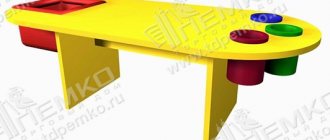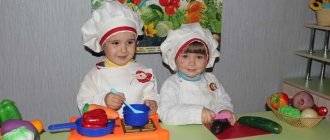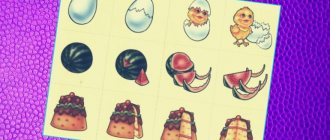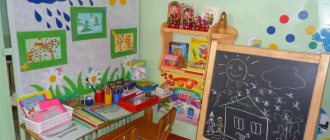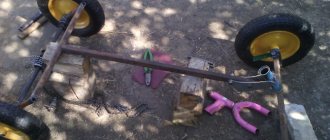General requirements for toys
Children in the younger group are very inquisitive and actively explore the world around them. They are interested in touching objects, examining them from all sides, breaking them and taking them apart. Many people do not miss the opportunity to taste the toy. Therefore, when arranging a garden, safety comes to the fore. Two- and three-year-olds do not always understand that something can harm them. Therefore, toys with small parts, sharp corners and loose elements are strictly prohibited. Make sure that the composition does not contain flammable or toxic materials. All parts should be easy to grip; there should be no splinters, burrs, or chips on the surface! “Talking” and musical games should not make too sharp or loud sounds. The maximum volume that is comfortable for a child’s ear is 70 dB.
What else you need to know about toys for younger preschoolers:
- They need to be selected taking into account the age characteristics of the children. If a child, due to his age, does not understand how to manipulate a complex toy (for example, a construction set with hundreds of parts or a controlled crane), then interest in it will quickly fade away.
- Toys should be multifunctional, broaden their horizons, and stimulate the child’s cognitive and research activity.
- They should evoke positive emotions, teach kindness and good deeds. No creepy monsters or characters with evil faces - this can provoke aggression, hysteria in children, and simply greatly frighten them.
Children spend most of the day in kindergarten. According to the Federal State Educational Standard, it is necessary to create for them a subject-spatial gaming environment that will not only be pure entertainment, but will also give an idea of the real world. Place your bets on popular self-learning toys. In the process of interaction, children intuitively understand how to handle them correctly. Such toys include aids based on the Montessori school method: sorters, lacing, busy boards, insert frames, wooden puzzles, boards, sensory bags, tactile books, etc. They help to learn about the main properties of surrounding objects (shape, size, color, texture), train logic, concentration and fine motor skills.
Provide easy access to toys in the playroom. They should be located in containers, boxes or on shelves at the height of children. For games with many small parts, consider packaging that closes tightly and securely.
Playmobil Magic Garden
Playmobil Fairy Grove set with unicorns. A world of magic and fun awaits those who build it with Playmobil Fairy Garden sets.
Known for its well-made, incredibly fun play sets, Playmobil once again sets the bar with its Magic Garden sets. This is an amazing world full of magical jewels, fairies, animals, mystical shelters, thrones, flowers...
High German quality, colorful details ideal for small hands. Each of the new Playmobil series is an event. All series complement each other. Collect your world for years!
What are the toys made of?
Let's look at the main materials from which children's toys are made for junior groups 1 and 2.
- Plastic. Typically this is polyvinyl chloride, polypropylene or polystyrene. A huge number of toys are made from plastic: cars, construction sets, cubes, sets of dishes, pyramids, sandbox accessories, vegetables and fruits, etc. Plastic has a rich color scheme, and the toys themselves are bright, often interactive and multifunctional. Plastic products are produced in Russia and in huge quantities in China. You need to be especially careful with Chinese-made toys, because plastic often contains components that are harmful to health: phthalates, phenols, heavy metals. When purchasing plastic toys for children in a kindergarten, be sure to check whether they comply with the requirements of GOST and SanPin. Such toys have a quality certificate and are marked “does not contain phenols or phthalates.” You can recognize a “harmful” toy by its pungent chemical smell, paint that stains your hands, or plastic burrs along the edges.
- Tree. For the production of games, species that can be easily processed are used: birch, beech, pine, etc. They are environmentally friendly and do not harm the child or the environment. Among the wooden toys there are many educational aids, puzzles, construction sets, puzzles - everything that develops motor skills and tactile sensations. Wood is heavier than plastic. By touching it, the child understands the real weight of the object: it takes some effort to lift and move the wooden figurine. Laconic toys that are not overloaded with details awaken the imagination and provide unlimited scope for imagination. If the toy is not painted, you can paint it together with the teacher or leave it in its natural form to see a cut of a real tree with growth rings and veins.
- Textile. Soft toys, puppet theater characters, cubes, and educational felt books are made from it. Fabric dolls must have a solid frame so that the body does not deform or bend during play. In a soft stuffed toy, the seams must be strong and neatly stitched so that the filler does not come out. Sharp objects, glass, cotton wool, and granules with a diameter of less than 3 mm are not allowed as filler.
Most toys combine different materials. For example, a bodyboard on a wooden base usually has metal locks and latches, plastic beads, fabric characters, laces, and zippers. Such a variety of textures, rough and smooth surfaces perfectly develop sensory experience, sharpen the accuracy and coordination of hands and fingers.
Puppet Theatre
Melissa & Doug Deluxe Puppet Theatre: Instead of heading to the local children's puppet theater (although that's worth doing, too, someday), let the kids act out their games with puppet theater sets.
There's a lot more than just glove puppets here.
For example, the Melissa and Doug Deluxe Puppet Theater set has a sturdy base and lots of detail - a movable clock for creating showtimes and an erasable chalkboard.
You buy dolls (or make them yourself) as you wish.
Toys for speech development in the younger group
From the age of 2, the child begins to enrich his active vocabulary, construct phrases, and attempt meaningful dialogue. Therefore, you need to pay attention to games for fine motor skills and manipulation of objects. Speech and motor skills are inextricably linked: the brain centers responsible for speech are located near the motor area. The best stimulants for speech development will be:
- sorters, labyrinths, lacing beads - train the accuracy of actions;
- business boards based on cartoons or fairy tales - develop imagination, imagination, teach how to play out scenes and at the same time interact with elements (open and close windows, rearrange a character in a train, etc.);
- musical toys: metallophones, xylophones - develop coordination, teach you to distinguish sounds, feel the rhythm, encourage you to hum a melody;
- folk toy matryoshka - introduces children to Russian folklore, promotes speech development with the help of riddles, counting rhymes, and nursery rhymes;
- cards with images of animals, objects, phenomena - each card can be examined and discussed what is depicted.
During the game, the teacher needs to talk through all the actions with the children, imitate the sounds of animals, speak slowly and clearly, and pronounce each sound. Kids like to repeat everything after adults, so they will happily pick up phrases and become participants in the “dialogue.”
Guitars and other musical instruments
Children love toy musical instruments. This is a good gift. Electric piano “Masha and the Bear”.
If you yourself know how to play at least a little, show your child the first chords and the simplest melodies. If you don’t know how to play at all, choose programmable musical toys, synthesizers, and others - ones that will allow your child to extract pleasant sounds from the instrument even without any skills at all.
While children dance joyfully to their programmed tunes, they are actually developing their own personal perception of music and gaining a sense of rhythm.
List of toys for 1st junior group
Junior group 1 includes children from 2 to 3 years old. They are often restless and very active. Therefore, they need a constant change of activities so that active games alternate with “developmental games” that require concentration and perseverance. Wooden toys are a priority here: they are safe, understandable, and contribute to the development of imagination and creativity.
We have selected 10 toys that a group of little ones definitely cannot do without.
- Busy boards, especially thematic ones, based on fairy tales. Objects united by one theme are collected on one surface. This will allow children not only to develop tactile skills, but also to use their imagination, come up with scenes and stories with characters on the board.
- Wheelchairs - hone your sense of equilibrium and balance.
- Toys for stringing parts, tying or screwing: sorters with pins, pyramids, lacing.
- Large cubes with numbers and letters are the first steps to understanding mathematics and writing.
- Puzzles where you need to assemble a whole picture from 4-5 pieces.
- Insert frames with images of animals, transport, fruits, vegetables, etc.
- Simple wooden construction sets with 25-30 parts.
- Labyrinths with several challenging bead routes.
- Cut-out pictures and educational cards depicting letters, cars, fruits, vegetables, and various household items. In this case, the child compares the visual image in the picture with the spoken word. Having remembered, in the future he can easily say the name of this or that object.
- Balls, ring throws, sandbox sets, etc. everything for outdoor games.
During the lesson with toys, the first younger group only begins to engage in productive activities: drawing, design, attempts at story-based play. It is important for a kindergarten teacher to support these endeavors, take an active part in the game, and comment on the actions.
Puzzles and puzzles
by ThinkFun.Get your preschooler to think and solve puzzle problems. This is great mental training.
Today there is an incredible number of different puzzles and puzzles, from which you can choose games on any topic. Check out puzzles from ThinkFun (with one of the most famous puzzles called Rush Hour) and Bondibon are the best options, especially if you're looking for a gift.
The advantage is that you can take these games with you on the road and prevent your child from getting tired and bored.
List of toys for 2nd younger group
The 2nd younger group includes children from 3 to 4 years old. Fine motor games are still important for them, but role play also appears in the activity. This is where toys come in handy, with the help of which kids come up with various scenarios and simulate real-life situations. Children learn to play together and show creativity. Therefore, to the previous list of materials for the first group we will add a few more:
- Calendar games on a wooden base. They are similar to busy boards, but their purpose is to teach the child to determine the time, day of the week, season. These manuals are bright and colorful, the numbers on the dial are clear, and the weather and season are indicated with a caption and pictures to make them easier to remember.
- Role-playing games on various topics: doctor’s and hairdresser’s kits, grocery baskets, household appliances, dishes. Girls like dolls and doll houses, boys like robots and fantastic animals.
- Lotto and dominoes. Promote the development of speech, memory and logical thinking. They are convenient to play with a whole group, but only under the supervision of a teacher.
- Various types of public transport and cars.
- Finger theater, hand puppets and folding theater screen.
Games that deepen knowledge about counting will be useful: business boards with numbers, abacus, counting sticks, fraction puzzles. Construction sets for the second junior group of kindergarten are much more complex; they contain more details and small elements.
Play equipment in the garden needs to be changed and updated regularly. Over time, any toys become outdated, worn out and simply boring. But competently equipping a kindergarten is only half of success and harmonious development. For young children, the most important thing is to introduce a new toy correctly. Try to clearly explain and clearly show how it should be handled. And most importantly, do not forget about safety rules and age-appropriate toys
Travel kits
Modern life consists of highways, highways, railroad tracks, and airplanes. Let your child create his own version of the path, and then roll trains or cars along it. Chuggington train track.
Many toy roads include track parts, building items, flexible tracks, and motorized cars. Your little engineer will be able to create his own highways, complete with bridges.
The funny Chuggington trains are familiar to many children from the animated cartoon series and are a welcome gift for many boys.
Traveling is fun!
Educational tablets and children's computers
Learning reading, math, English, geography can be so much fun!
One of the best ways to teach a preschooler to read is to constantly read aloud to the child from early childhood. Reading is a great way to understand each other well by discussing what we read. There is nothing better than when you spend time with your child, reading and counting with him, playing educational games.
However, there are times when you are busy - cooking, talking on the phone, cleaning. At such moments, an educational tablet or a children's computer with different educational programs, tasks, and games will help to keep the child occupied.
Which one? There are many of them - choose!
Game centers
Great joy for children and adults - swings, slide, sandbox, trampoline.
I must admit that he is big. And dear. But if you have the means and space, afford yourself such a gaming center. Durable and colorful, with swings, rope ladders, rings, and many other features. There are a wide variety of gaming centers available for purchase today. Wooden, plastic, inflatable. As a last resort, if there is very little space, you can at least hang it at home.
Such centers help the child develop physically, and this is very important.
